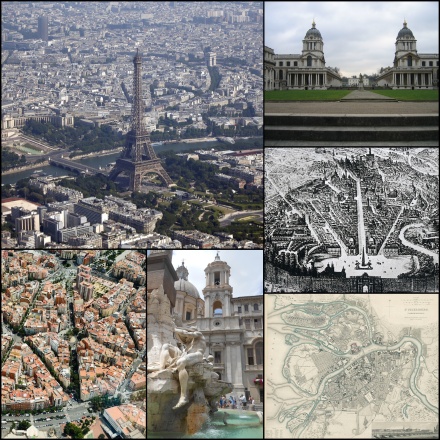When walking down the streets of cities like Rome and Paris it is hard not to feel an overwhelming sense of grandeur and an an eminence of wealth, power and order which the cities were actually created to convey. These cities, among many others, were designed under the inspiration of the baroque period. Originating in late sixteenth century Europe, baroque style was in large part a response to the aftermath of the protestant reformation and the rebirth of the Catholic church. The counter reformation and extreme application of catholicism to daily life led to a major shift in architecture, art and culture of the time. Typical baroque style includes elements such as very large structures with impressive ornamentation and monuments, government buildings, and cathedrals as a focal points with clear vantage. Baroque style is meant to demonstrate order, structure, and power and appeal to emotions through elaborate decoration. Dominance could even be asserted physically with the common inclusion of very wide avenues to facilitate the marching of troops and make it impossible for citizens to barricade the streets. Baroque cities are a product of the areas social and political institutions and their desire to reflect their absolute power through the landscape. In the case of Rome, for example, this power belonged to the Catholic church.
For centuries Rome has been a front runner in european art and has inspired both the culture and design of cities all over the globe. By the seventeenth century Rome has established itself as a triumph of catholicism and the arts which can be clearly seen in the design of the city. Under the orders of the papacy the expansion of Rome from the traditional gridded city to one of exceptional extravagance was under way. Under the vision of pope Sixtus V the city was to be reconfigured into a star shape allowing vast avenues to link grand basilicas and other monuments (metmuseum.org). Many palaces, elaborate sculptures, and other monuments such as bridges were also commissioned during the Roman baroque period. Elements such as numerous giant columns, the massive dome on the St. Petersburg basilica and large ornamental facades are reflective of baroque style and convey the power and dominance of the catholic church.
The french also began to design their cities according to the baroque spirit as a result of the crowns desire to assert its power. One of the most obvious examples of baroque architecture and style is the place of versailles which is famous for its hugely extravagant beauty. The city of Paris shares a great deal of baroque elements with Rome with huge avenues connecting plazas and providing a clear view and focus of monuments such as the arc de triomphe and the Eiffle tower. Even independently these structures convey an overwhelming sense of power and wealth, a staple of the baroque era.
In class we discussed the development of Washington DC in the aftermath of industrialization and urbanization. The area was developed in the baroque tradition and can be easily linked to Paris and Rome. Because Washington DC is not a state but under the direct control of the federal government it was exempt from democracy and was laid out as an expression of power. The city is essentially on a gridded system and has seen fluctuations in upkeep yet was designed to be a display city and draws its inspiration from baroque cities such as Rome and Paris. Elements such as wide avenues connecting monuments and important buildings were borrowed from baroque architecture as a way from the US to assert its new found independence and political dominance.

As last week, please reblog and write at least 500 words about how these representations of the baroque period of European urban development relate to our lectures from this week.